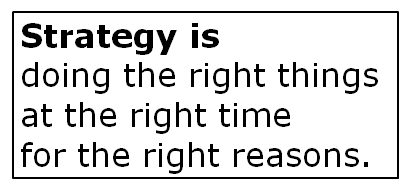“An accurate plan poorly implemented is more successful and effective than a vague or generic plan implemented with brilliant precision.” — Author unknown
Just about everyone in the business world agrees that planning is important and has some value. Before you can decide on an approach to planning, however, it’s important to think about who is asking you for your plan and what purpose it will serve.
For Example:
- If a loan officer at the bank asks to see your plan, he is primarily interested in reviewing your financial projections to make sure you can repay your debt.
- If a venture capitalist asks to see your plan, she is primarily interested in discerning the return on her investment in your business idea.
- If an employee asks you about your plan, he is seeking clear direction so he can successfully contribute on the job and earn his salary.
- As a solo entrepreneur, you are looking to focus your efforts on ensuring the success of your business and optimizing the use of your time. We want to focus on doing the 20% that makes 80% of the difference.

A common mistake people make in business is that they take action without getting clear and accurate direction on a few key things before they start. To solve this problem, I suggest that people start with a written Situation Analysis.
The Situation Analysis is simple to do if you break it down into sequential steps. Writing clarifies the logic. If you try to do it all in your head, think about it all at once, or attack the steps in the wrong sequence, the clarity and accuracy you seek with the exercise is much more difficult to achieve.
Clarity is determining who your customers really are and if they really need your services.
Accuracy is not misleading yourself with opinions and interpretations, but rather dealing with the facts related to the opportunity.
5 Beginning Steps to a Clear and Accurate Business Foundation
There are multiple aspects of your situation to consider, but the five primary considerations are your customer, your offer, your business development strategy, pricing and industry trends.
1. Your Customer
Have you clearly identified your customer?
What are the customer’s needs, wants, and desires?
Are you clear about the problems you can help them solve?
How many people have these problems (i.e., what’s the size of the market)?
What things does the customer want to accomplish?
Who is the decision maker within the customer’s organization?
Who are the key decision influencers?
What is the decision-making process the customer will use to say “yes” or “no” to your offer?
Use data and facts throughout your analysis whenever possible, not speculation or hope fors. The information you need can often be obtained with conversations with potential customers and market surveys. You will want to ask: “How often do you have this problem? How important is it to you to solve this problem? How would you personally benefit if the problem were solved?” Some of the core benefits to the customer may include achieving their goals, increasing revenue, increasing productivity, saving time, and increasing security.
2. Your Offer
After you have clarity about the customer, the next step is to be clear about the programs, services, and products you will offer. If you are clear about the customer’s problems, it will be easier to get clear about what you will need to offer to satisfy those problems. Put your offers in ranked order of opportunity and focus your efforts in the highest leverage areas.
3. Your Business Development Strategy
My experience is that solo entrepreneurs tend to waste a lot of time working on their marketing materials prematurely. An effective business development strategy is best developed after you’re clear about your customers and the problems you will solve. What are the materials and tactics needed to effectively communicate your offering to potential customers? Possibilities include an executive summary, sales sheet, business cards, face-to-face networking, public speaking, and perhaps an active blog and social media presence.
4. Pricing
What value are you bringing to solving the problem for your customer? What does the competition charge for a similar offering? An effective pricing strategy will take both of these factors into consideration.
5. Industry trends
My observation is that the trends in the industry, if not monitored correctly, can act like a brick through the front window. What are the trends in your industry and that of your customer? Are you able to step into a trend that is going to create an opportunity or are you stepping into a trend of a diminishing market? Examples of industry trends include innovation, government intervention, and the economic climate.
Learn more about performing your own Situation Analysis and developing a more extensive business plan by signing up for “Focus on Results – A Four Stage Business Planning Process” in FREE STUFF.
Now it’s your turn.
Are you being crystal clear about a specific customer you are targeting and the set of problems your are trying to solve or are you trying to be all things to all people?
Are you clear about the problems you solve or the conditions you eliminate with your services, programs, and products?
When you can answer “yes” to these 2 questions, your life will be easier and your efforts to develop your new business will be more productive.

